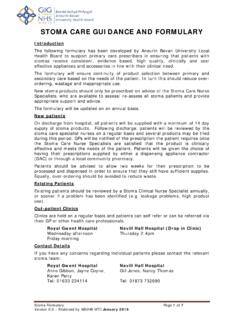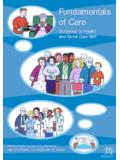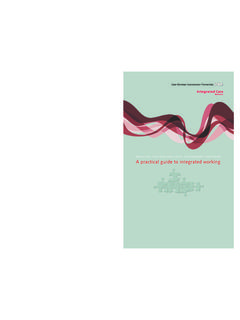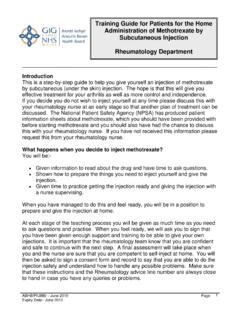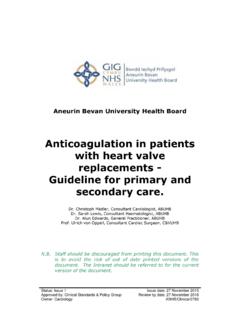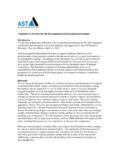Transcription of HEALTHCARE ASSOCIATED INFECTIONS – FACTSHEET / FAQs
1 HEALTHCARE ASSOCIATED INFECTIONS FACTSHEET / FAQs There is considerable interest in HEALTHCARE ASSOCIATED INFECTIONS , and it is important that patients understand what their risk of infection might be if they go into hospital or receive HEALTHCARE treatment. HEALTHCARE ASSOCIATED infection is a complex subject and unfortunately some of the information currently in circulation can be misleading. This FACTSHEET aims to explain some of the issues and provide a starting point for further discussion with your doctor. What does the term HEALTHCARE ASSOCIATED infection (HCAI) mean? HEALTHCARE ASSOCIATED infection refers to INFECTIONS that occur as a result of contact with the HEALTHCARE system in its widest sense - from care provided in your own home, to primary care, nursing home care and care in acute hospitals.
2 The term has recently been coined in recognition that increasingly complex procedures are undertaken outside hospitals. Previously, when most complex HEALTHCARE was hospital based, the term hospital acquired infection was used (see next entry). What does the term hospital acquired infection (HAI) (also known as nosocomial infection) mean? Hospital acquired infection has a strict definition. It refers to an infection which develops in a patient 48 hours or more after admission to a hospital. INFECTIONS that occur within the first 48 hours are considered to be derived from the community and were incubating prior to admission. These are then referred to as community acquired INFECTIONS (see next entry).
3 What does the term community acquired infection (CAI) mean? Community acquired infection is any infection which a patient is suffering from when they come into hospital or occurs within the first 48 hours of admission. In this latter case, it is assumed that the patient was already incubating the infection which they picked up in the community prior to admission. The 48 hour cut-off is somewhat arbitrary as INFECTIONS have variable incubation periods. Nevertheless, some standard definition is useful when considering likely sources of infection and 48. hours has remained the standard for many years. What is a hospital outbreak ? An outbreak is any two or more cases of an infection of the same type, where a common link can be established.
4 A hospital outbreak simply reflects a link with the hospital. Some outbreaks in hospitals may be a reflection of whatever is circulating in the community but the close confines in hospital present opportunities for spread - for example the viral gastroenteritis caused by the norovirus, which is also know as winter vomiting disease . (Similar outbreaks are sometimes experienced in other confined locations such as cruise ships). Other hospital outbreaks are as a result of hospital spread - antibiotic ASSOCIATED diarrhoea caused by the bacterium Clostridium difficile. Why do people develop INFECTIONS linked to HEALTHCARE ? People are admitted to hospital either because they are already ill or they require some form of procedure.
5 Commonly this will be surgery but people may also be admitted for special investigations. In any of these situations the body is compromised and is not behaving in the same way as a healthy body. People who are ill on admission to hospital will already have an immune system that is compromised in some way. This underlying illness makes them more prone to developing infection. 2. INFECTIONS can be caused by bacteria or by viruses. Bacterial INFECTIONS can be treated with antibiotics;. but with most viral INFECTIONS it is only possible to treat the symptoms, not the virus itself. Surgery will also suppress the immune system, while at the same time the body's first line of defence - the skin - will be breached, allowing organisms to gain access to parts of the body where they can multiply and set up an infection.
6 Similarly, many special investigations will introduce instruments into normally sterile parts of the body. While the instruments themselves will normally be sterile, they inevitably pass through parts of the body that contain normal bacteria and if these bacteria gain access to new sites, INFECTIONS may be established. What are the main categories of HEALTHCARE ASSOCIATED infection? The main types of HEALTHCARE ASSOCIATED INFECTIONS are: - Urinary tract INFECTIONS - cystitis, kidney INFECTIONS ;. - Lower respiratory tract INFECTIONS - brocho-pneumonia, lobar pneumonia;. - surgical Wound INFECTIONS - stitch abscesses ASSOCIATED with the suturing of a surgical wound.
7 - Skin Infection - infected diabetic ulcer, infected varicose ulcer;. - Blood Stream INFECTIONS - septicaemia. Urinary and respiratory INFECTIONS are the most common. What factors can increase a patient's risk of infection? The severity of any underlying condition and the body's own ability to fight infection will have a role. Equally, the use of medical devices as part of a patient's management - intravenous or urinary catheters - breach the body's normal defences and increase the risk of acquiring infection. For example, sometimes urinary catheters have to be inserted into the bladder, particularly if a patient is unconscious or has had surgery in or around the bladder or kidneys.
8 This artificial access can be ASSOCIATED with initial colonisation by a person's normal bacteria which can then lead to an ascending infection into the bladder. Following surgery, particularly of the chest or abdomen, pain can lead to restricted breathing which may allow a respiratory infection to develop. This is why many patients require chest physiotherapy after surgery and why pain management is so important. By getting the patient to cough and breathe normally, access to the lungs by pathogens can be avoided. Finally, the longer a patient remains in hospital, the more opportunity they have of encountering an antibiotic resistant organism, which will require the use of antibiotics that may have more side-effects.
9 Are some patients more likely to acquire an infection or to be worse affected if they do get one? The sicker a patient is or becomes, the more prone they are to infection. The immune system is not fully developed at birth so the very young are at risk. As the immune system develops, so children are better able to cope with infection. The elderly are also more prone to infection but this may be because they are more likely to have an underlying disease. Patients who are receiving treatment with certain kinds of drugs which suppress the immune system will also be at increased risk. Are some surgical procedures more likely to result in an infection than others?
10 The more complex a surgical procedure is, the more tissue damage may occur. Where surgery involves sites of the body that are not sterile for example the gastrointestinal tract - bacteria from the non-sterile sites may gain access to sterile sites and set up infection. 3. Additionally, where implants are used, some bacteria are able to stick to the plastics and metals and this may help establish an infection. What impact do INFECTIONS have on patients? INFECTIONS can range from the mild to the severe and the impact will therefore vary. Any infection, even if mild, will be unpleasant for the patient and can lead to a longer stay in hospital.
